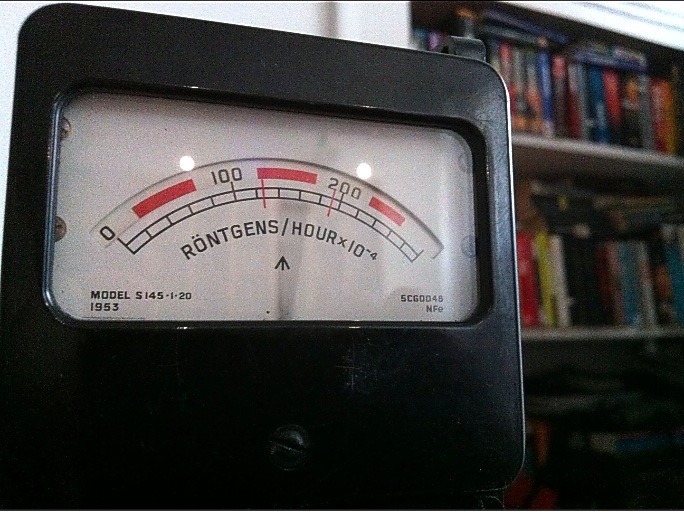A simple quasilogarithmic amplifier detector was developed for the JLH amplifier.
Designed to work with arrow VU meters
Simple and cheap components are applied.
Scheme:

Amplitude characteristics

The circuit has a boost circuit
Appearance of the front and rear together with a VU meter SO-53


Can be used with almost any VU meter and any amplifier.
Designed to work with arrow VU meters
Simple and cheap components are applied.
Scheme:

Amplitude characteristics

The circuit has a boost circuit
Appearance of the front and rear together with a VU meter SO-53


Can be used with almost any VU meter and any amplifier.
Yes, this PCB is adapted for SO-53 type VU meter. But there is no special problem to adapt PCB for other VU meters.
Nice.
I made a similar thing out of an interesting meter movement I found second-hand:

I made a similar thing out of an interesting meter movement I found second-hand:

Last edited:
You have a real measuring device
In my case, these VU meters will be installed in the JLH amplifier.

In my case, these VU meters will be installed in the JLH amplifier.

I couldn't find anything about a KP1436 IC, the photo of the board shows a MC34119 Low Power Audio Amplifier. Is it indeed the MC34119?
Yes, KR1436UN1 and MC34119 analogues. I bought chips from the same factory with two different markings.
I dont see why you are using a log amplifier ... the Arsonval is linear but the scale scale printed on the faceplate is a log scale ....
You should test the meter with a dc power supply and a resistor .....
maximun current for full scale +3 dB
70 % of maximum for 0 dB
50 % of maximum for -3 dB
10 % of maximum for -7 dB
otherwise
Nominal current fo 0 dB
141% of nominal for +3 dB
71 % of nominal for -3dB
50 % of nominal for -6 dB
10 % of nominal for - 10 dB
As far as I know you dont need a log amp to drive the meter .....
You should test the meter with a dc power supply and a resistor .....
maximun current for full scale +3 dB
70 % of maximum for 0 dB
50 % of maximum for -3 dB
10 % of maximum for -7 dB
otherwise
Nominal current fo 0 dB
141% of nominal for +3 dB
71 % of nominal for -3dB
50 % of nominal for -6 dB
10 % of nominal for - 10 dB
As far as I know you dont need a log amp to drive the meter .....
I dont see why you are using a log amplifier ... the Arsonval is linear but the scale scale printed on the faceplate is a log scale ....
You should test the meter with a dc power supply and a resistor .....
maximun current for full scale +3 dB
70 % of maximum for 0 dB
50 % of maximum for -3 dB
10 % of maximum for -7 dB
otherwise
Nominal current fo 0 dB
141% of nominal for +3 dB
71 % of nominal for -3dB
50 % of nominal for -6 dB
10 % of nominal for - 10 dB
As far as I know you dont need a log amp to drive the meter .....
I can understand that. I used the VU meter I had.
The scale of this meter can be easily replaced by a homemade. I made a quasilogarithmic amplifier for another reason.
At a comfortable volume the usual linear VU meter shows almost nothing the Arrow lies at the beginning of the scale and almost does not move.
So I applied dynamic range compression to visualize the performance of the amplifier.
I understand your situation but then all you have is a moving needle ....
With a régular set up ( no log amplifier ) you can know how much power the amp is driving.
If you calibrate for 0 dB - 6.3 volts RMS you have 5 watts in 8 ohm
then
+3 dB - 8.9 volts RMS you have 10 watts in 8 ohm
-3 dB - 4.5 volts RMS you have 2.5 watts in 8 ohm
-7 dB - 2.8 volts RMS you have 1 watts in 8 ohm
-10 dB - 2.0 volts RMS you have 0.5 watts in 8 ohm
-20 dB - 0.63 volts RMS you have 0.05 watts in 8 ohm
With a régular set up ( no log amplifier ) you can know how much power the amp is driving.
If you calibrate for 0 dB - 6.3 volts RMS you have 5 watts in 8 ohm
then
+3 dB - 8.9 volts RMS you have 10 watts in 8 ohm
-3 dB - 4.5 volts RMS you have 2.5 watts in 8 ohm
-7 dB - 2.8 volts RMS you have 1 watts in 8 ohm
-10 dB - 2.0 volts RMS you have 0.5 watts in 8 ohm
-20 dB - 0.63 volts RMS you have 0.05 watts in 8 ohm
- Status
- Not open for further replies.
- Home
- Source & Line
- Analog Line Level
- A simple indicator of the output power of the amplifier